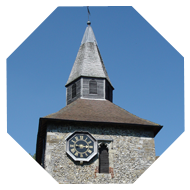
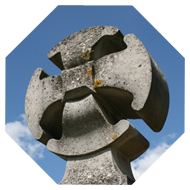
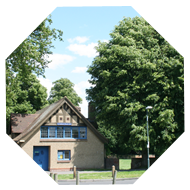
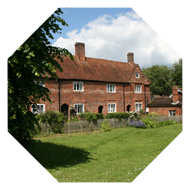
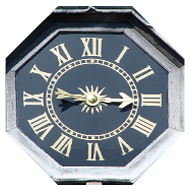

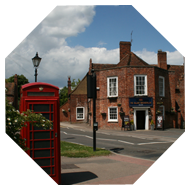
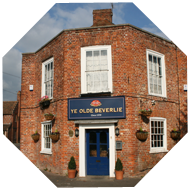
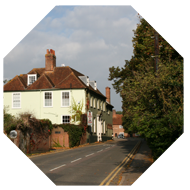
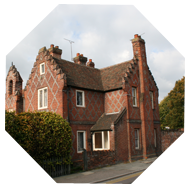
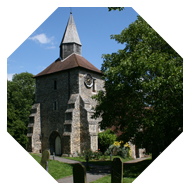

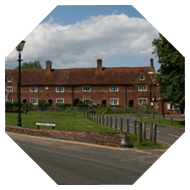



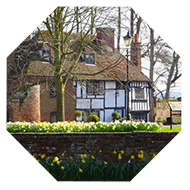

Historic St.Stephen's : Various articles
An occasional series of articles on Historic St.Stephen's with help from our residents.
To mark the 75th anniversary of VE Day, Ron Waters's wartime memories
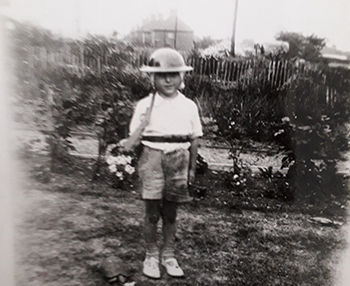
I was born on Christmas Day, 1933 and we moved to St Stephen’s when I was about three. I don’t really remember much but the first thing I remember is war breaking out. They were expecting the invasion and to be bombed and two of my cousins moved down from London to live with us.
I was about six I suppose, and we were walking one Sunday morning in September in St Dunstan’s and the siren went. We didn’t know what it was because although we knew war was going to start, we didn’t think we were going to be bombed. It was really a moment of panic. My two girl cousins, who were about twelve or thirteen, were crying and a policeman came along and he took us to the police station in Pound Lane. They didn’t really know what to do either so we had to stay in the cells until about 12 o’ clock. Then they decided it was all quiet and a policeman took me home to Broad Oak Road on the saddle of his bike while my cousins walked alongside.
Then everything went quiet until we were evacuated to Reading. We went on the train and we all had our gas mask boxes. We went to the West Station and a special train came in. Everybody we knew, all the kids, all went to Reading. When we got there, the WVS were sorting us out and they said to the families, ‘Well, you’ve got two bedrooms and you have to have evacuees.’ There was my mum and my granny and we went to this house and I can remember sleeping in a bed; they were at one end and I was in the middle at the other and that’s how we were. The people didn’t want us so we only stayed there for a fortnight as my mum wrote to my dad and said, ‘Look, we want to come back,’ so he sent the money and we left. On the trains, you didn’t know where you were as the station signs were gone but we got to Canterbury West and my dad was there and took us home.
I saw some of the Battle of Britain. We lived in Broad Oak Road, up on the bank there; it was called Stour View then, opposite the allotments, just round the corner from St Stephen’s Road. My dad built an Anderson air raid shelter in the back garden. There was a little road opposite, by the river, where there were cottages, called Cottonmill Cottages. There was a water pump there and they had a group of about six Anderson shelters up on the top where they went when the air raids came.
I can remember Canterbury being bombed. It lasted about a week and it was at night and we all went down into the shelter where I slept. It was quite frightening but when you’re a kid you don’t realise someone is trying to kill you. We could hear the bombs dropping down and my dad took me up to the top of the bank overlooking where the swimming pool is now, and the cathedral was still standing, but the city was all flames. I think they used incendiaries first, then they sent in the bombs with explosives and it spread all the fires. The next morning we walked down St Stephen’s Road [kids used to collect shrapnel and things from the bombs] and through the coal yard by Canterbury West. There were trucks in the sidings and a dead horse on the road. Where I live now [St Stephen’s Road near the Causeway] there was an unexploded bomb on the opposite side of the road and we didn’t know.
My next experience of the war: In those days, all the families would go hopping and used to get the money for the kids’ uniforms and things. There were troops stationed up by Alcroft Grange, troops all around there and I don’t know if they [The Germans] knew but I can remember a Messerschmitt coming over and machine-gunning us in the hop gardens. Go up to Alcroft Grange, along that long road and down the other side and it was all hop gardens. I think you could get to it from the bottom of Tyler Hill; there must have been a track from there. There were about three hop gardens and we used to do one and move on to the next. I saw the Messerschmitt come over and I actually saw the pilot. It was powder blue underneath and camouflaged on the top and as it came over, he swerved back and had another go. He was just shooting at us along the hop gardens. We were all lying flat and nobody got hurt, thank goodness.
Another time while we were up there, there was a daytime raid on Canterbury and German raiders coming over and they dropped a bomb on Dennes Mill. Of course, we all used to listen to Lord Haw Haw at night and he said, ‘Today we bombed Canterbury and we hit a flour mill’ but they didn’t, they missed it but they must have known they were pretty close to it. Then there were various other bombs and of course, we saw the Battle of Britain. As we were kids we used to have little silhouette books so we knew which plane was which. The other thing I can remember is that we had double summer time to get the harvest in so it was still light at half past ten or eleven. I can remember seeing the German bombers, there seemed to be hundreds of them, going up the Thames to bomb London and the Spitfires were going over there and trying to shoot them down. Well, it was marvellous for kids.
The other thing I remember is a plane, it was a German bomber, and it had been hit. It was quite low and it was trying to make its way back, and three spitfires came over and shot it down and it crashed over in Rough Common. I said to my dad, ‘Shall we go over and have a look?’ and Dad said it was further away than it seemed so we didn’t go.
When I was evacuated, I had to go to school. My dad was too old to fight; he had fought in the first war in the navy and was torpedoed twice. Before I was evacuated, I went to the Methodist school, St Peter’s, but then it was called the Methodist or the Wesleyan school and it was supposed to be the best school but I was struggling a bit there. When I was evacuated, even though I was only there for a fortnight, we went to a local school. I can only have been seven at the most and we had to get two buses, one to go into Reading and then change buses and go out to the school. One of my neighbours was two years younger than me-about five-so I used to take him to school, changing buses. It was a church school, Mary Magdalene’s or something like that. I must have only gone there for a week and after we left, he had to do the journey on his own.
When I got home, they said you don’t want to go to the Methodist school [now St Peter’s] with all the daytime bombs in Canterbury so I went to St Stephen’s School. [This is the Old School opposite the Olde Beverlie] There was one classroom that was divided; that was the infants and the next year, then the top class round the back. Mrs George took the infants, Miss Golding was the headmistress and Mrs Bekhusen taught us.
There were about eighty or ninety children at St Stephen’s in three classes. These children mostly had been evacuated but they didn’t like being away from home and they didn’t like their families being split up so they started to creep back. I was the air raid warning monitor and used to have to stand by the outside door when the siren went. The shelter was at the back of the school. A stream used to run along there. It was a stone building on the surface, quite solid, and we used to sit along the side in forms and sang songs about how many men went to mow, Bill Bailey, Widdicombe Fair, Uncle Tom Cobley, green bottles and times tables - we repeated them and repeated them. One day, I thought I’d heard the siren but I think it was a lorry coming down the road and I got them all in the air raid shelter. I was a bit more careful after that!
At the back of the old school we had little plots and a stream came down there. There was a brick well in the school grounds. [This is still there.] Where Archbishops is there were allotments. I stayed there until I was 11 and then went to St Dunstan’s in London Road where there were only three of four classes. I ended up as Head Boy.
Once we got over the Battle of Britain, it didn’t seem quite so bad but we did have daylight raids. You’ve heard about the Saturday afternoon raid? It was wintertime, October or sometime like that, and a funny thing happened. When there was a raid; first of all you heard the siren and then, when they were closer, the hooter [we called it Tug Boat Annie] went but we just heard the hooter. I thought that was strange and I walked round the back and past my neighbour’s house and I saw these aeroplanes coming across from St Martin’s Hill and they were very low. I thought they were ours because I could only see them head on but then I saw a bomb drop out of one and I ran in. We used Morrison shelters then as Granny was still living with us. Mum was at the corner shop [on the St Stephen’s roundabout]. I said, ‘Get in the shelter quick.’ Granny wasn’t very quick but we all got in there and heard the bombs fall. There was quite a lot of damage and they had bombed the barracks on Sturry Road where Brymore is now. My sister-in-law lived in Sturry Road, she was about the same age as me and was on a bus that was turned over. She was shell shocked for quite a time.
We used to play in St Stephens. It was marvellous. It was a wonderful place to play because it was all woods with big fields at the bottom. Where the school is now, if you looked up from the field you just saw a grass bank where The Terrace is. The tennis courts were there then but you couldn’t see them because of the bank. There was a walnut tree just behind the shop and another big tree down the other end and cows in the fields and hedges. Beyond the end of Birdcage Walk was another field and then the orchard. At the end of Birdcage Walk on the right were more fields where Hever Place is and an orchard beyond that where Headcorn Drive is.
Another way to get to the woods was along Broad Oak Road, just before Farleigh road, you can still see that there used to be a track there and beyond there was a pathway that went over the railway gate and beyond that there was a pathway up to the woods.
There was a pond that we called the Stinky Pool with a wall along the side. A bomb landed right next to it, 20 feet from it, and made a crater. There was an island in the middle of the Stinky Pool and you could get to it by climbing over a sort of steel ladder. Later on, you could jump across to it. The bomb made a crater and felled a large tree and started a spring and it used to come down a little channel into the Stinky Pool. It was only a little spring but we used to dam it up and we played there a lot when I was a kid. [Did the island get bigger or was the water at a lower level?]
There was also a well, bricked up, somewhere on Tenterden Drive and the water used to come up over the bricks. We used to drink from it whether it was good or not but then they found a dead animal in it and we didn’t drink the water any more!
The best way to get to the chapel [on Tenterden Drive] was go to the Stinky Pool, then to Lychgate, where the forest started, all chestnuts. There was a stone path that turned at right angles from Lychgate and went past the chapel which was on the left. There were evergreens, I don’t know if they were rhododendrons, I can’t remember ever seeing them flower but it was maybe laurel, like an evergreen fence that went on and all round the chapel. It was never vandalised and was always open and you’d go in there and have a look. The door was on the back side of the chapel. [Ron says this because the path went round the other side of the chapel from where Tenterden Drive is today.]
You could continue up the path after the chapel, then there was a crossroads or a track you could go up, and there was a place we used to call Robin Hood’s Glen. It was all yew trees and there was another high wall and we never went beyond that. It was bricked up before we ever went there. It might have had a steel gate on it that you could see through. I would think that the path from Lychgate to Robin Hood’s Glen must have been over a hundred yards. It was quite a way beyond the chapel, about thirty yards beyond it. [We went to investigate where Robin Hood’s Glen was but the area has changed so much. We went behind the Community Centre, and up the path that then leads to the pond and open space on Longmeadow Way. You can see the magnificent wall which is still there.]
The Crescent and Moorfield area was a wood. It wasn’t all brambles and there were decent trees. Up round behind the pavilion, there was a path with horse chestnuts growing by the side of it. We used to get conkers from them. These must have been about 50/60 years old. In the other areas were ordinary sweet chestnuts, with about 6-inch trunks, and we were very disappointed one day when we came and they were all gone for the pit props at Chislet Colliery. This must have been in about 1943/1944. You could walk between the trees and it was a pleasant place to be.
We’d go right over to Downs Road and all round. There were just the few houses that had been built before the war at what is now the bottom of the road. It was all fields around there. There was a wall on the far side of Downs Road and we used to climb over that and there is a big field up there [there still is, on the right as you go up St Stephen’s Hill] and we used to go right over the wall and across the field and try and get mushrooms. There was a copse right in the middle of it about thirty feet in diameter.
There was a grocery shop where Porters is now, on Hales Drive. Mr Piddock, a sergeant in the Home Guard, owned it but we went to the shops on the roundabout. The newsagents has always been a paper shop and it was owned by Mr Pike, then Mr Mayne. There was also a fellow who used to repair shoes in the shop where the locksmith is now and it always reminded me of a Bernard Manning joke. Every time you went to collect your shoes, they’d say it would be ready Wednesday, then when you went there, it would be next week. So Manning says a cobbler finds a pair of shoes that had been there for ten weeks so he found the address and told the owner that he’d got his shoes and when he came to get them, the cobbler says, ‘They’ll be ready next week!’ I always remember that. The grocer, Mr Hore, lived at Tyler Hill and his shop was at the opposite end from the newsagents.
Haleswood was the only house on what is now The Crescent. There was a track behind the old St Stephen’s School that came down from the university where the tunnel is and went from there to Canterbury West but you couldn’t get across until they took away the railway line. Beverley Meadow has been there as long as I can remember but it was Beverley Farm in those days.
The pavilion was the tennis clubhouse that was roughly in the area where the house called Hickling is now. The driveway to Hickling is on Manwood Avenue, just before the turn into The Crescent. The tennis courts were on The Terrace and steps were built to allow access to the clubhouse or pavilion, as Ron calls it. Some of the steps remain in situ.
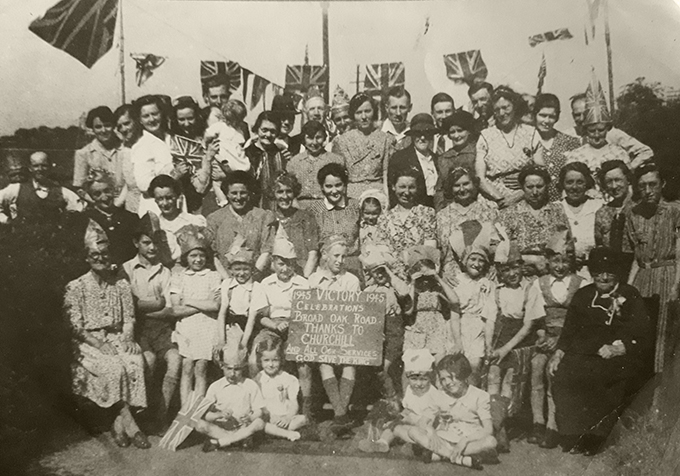
[My italics used for explanation. Pauline Waters]

I was born on Christmas Day, 1933 and we moved to St Stephen’s when I was about three. I don’t really remember much but the first thing I remember is war breaking out. They were expecting the invasion and to be bombed and two of my cousins moved down from London to live with us.
I was about six I suppose, and we were walking one Sunday morning in September in St Dunstan’s and the siren went. We didn’t know what it was because although we knew war was going to start, we didn’t think we were going to be bombed. It was really a moment of panic. My two girl cousins, who were about twelve or thirteen, were crying and a policeman came along and he took us to the police station in Pound Lane. They didn’t really know what to do either so we had to stay in the cells until about 12 o’ clock. Then they decided it was all quiet and a policeman took me home to Broad Oak Road on the saddle of his bike while my cousins walked alongside.
Then everything went quiet until we were evacuated to Reading. We went on the train and we all had our gas mask boxes. We went to the West Station and a special train came in. Everybody we knew, all the kids, all went to Reading. When we got there, the WVS were sorting us out and they said to the families, ‘Well, you’ve got two bedrooms and you have to have evacuees.’ There was my mum and my granny and we went to this house and I can remember sleeping in a bed; they were at one end and I was in the middle at the other and that’s how we were. The people didn’t want us so we only stayed there for a fortnight as my mum wrote to my dad and said, ‘Look, we want to come back,’ so he sent the money and we left. On the trains, you didn’t know where you were as the station signs were gone but we got to Canterbury West and my dad was there and took us home.
I saw some of the Battle of Britain. We lived in Broad Oak Road, up on the bank there; it was called Stour View then, opposite the allotments, just round the corner from St Stephen’s Road. My dad built an Anderson air raid shelter in the back garden. There was a little road opposite, by the river, where there were cottages, called Cottonmill Cottages. There was a water pump there and they had a group of about six Anderson shelters up on the top where they went when the air raids came.
I can remember Canterbury being bombed. It lasted about a week and it was at night and we all went down into the shelter where I slept. It was quite frightening but when you’re a kid you don’t realise someone is trying to kill you. We could hear the bombs dropping down and my dad took me up to the top of the bank overlooking where the swimming pool is now, and the cathedral was still standing, but the city was all flames. I think they used incendiaries first, then they sent in the bombs with explosives and it spread all the fires. The next morning we walked down St Stephen’s Road [kids used to collect shrapnel and things from the bombs] and through the coal yard by Canterbury West. There were trucks in the sidings and a dead horse on the road. Where I live now [St Stephen’s Road near the Causeway] there was an unexploded bomb on the opposite side of the road and we didn’t know.
My next experience of the war: In those days, all the families would go hopping and used to get the money for the kids’ uniforms and things. There were troops stationed up by Alcroft Grange, troops all around there and I don’t know if they [The Germans] knew but I can remember a Messerschmitt coming over and machine-gunning us in the hop gardens. Go up to Alcroft Grange, along that long road and down the other side and it was all hop gardens. I think you could get to it from the bottom of Tyler Hill; there must have been a track from there. There were about three hop gardens and we used to do one and move on to the next. I saw the Messerschmitt come over and I actually saw the pilot. It was powder blue underneath and camouflaged on the top and as it came over, he swerved back and had another go. He was just shooting at us along the hop gardens. We were all lying flat and nobody got hurt, thank goodness.
Another time while we were up there, there was a daytime raid on Canterbury and German raiders coming over and they dropped a bomb on Dennes Mill. Of course, we all used to listen to Lord Haw Haw at night and he said, ‘Today we bombed Canterbury and we hit a flour mill’ but they didn’t, they missed it but they must have known they were pretty close to it. Then there were various other bombs and of course, we saw the Battle of Britain. As we were kids we used to have little silhouette books so we knew which plane was which. The other thing I can remember is that we had double summer time to get the harvest in so it was still light at half past ten or eleven. I can remember seeing the German bombers, there seemed to be hundreds of them, going up the Thames to bomb London and the Spitfires were going over there and trying to shoot them down. Well, it was marvellous for kids.
The other thing I remember is a plane, it was a German bomber, and it had been hit. It was quite low and it was trying to make its way back, and three spitfires came over and shot it down and it crashed over in Rough Common. I said to my dad, ‘Shall we go over and have a look?’ and Dad said it was further away than it seemed so we didn’t go.
When I was evacuated, I had to go to school. My dad was too old to fight; he had fought in the first war in the navy and was torpedoed twice. Before I was evacuated, I went to the Methodist school, St Peter’s, but then it was called the Methodist or the Wesleyan school and it was supposed to be the best school but I was struggling a bit there. When I was evacuated, even though I was only there for a fortnight, we went to a local school. I can only have been seven at the most and we had to get two buses, one to go into Reading and then change buses and go out to the school. One of my neighbours was two years younger than me-about five-so I used to take him to school, changing buses. It was a church school, Mary Magdalene’s or something like that. I must have only gone there for a week and after we left, he had to do the journey on his own.
When I got home, they said you don’t want to go to the Methodist school [now St Peter’s] with all the daytime bombs in Canterbury so I went to St Stephen’s School. [This is the Old School opposite the Olde Beverlie] There was one classroom that was divided; that was the infants and the next year, then the top class round the back. Mrs George took the infants, Miss Golding was the headmistress and Mrs Bekhusen taught us.
There were about eighty or ninety children at St Stephen’s in three classes. These children mostly had been evacuated but they didn’t like being away from home and they didn’t like their families being split up so they started to creep back. I was the air raid warning monitor and used to have to stand by the outside door when the siren went. The shelter was at the back of the school. A stream used to run along there. It was a stone building on the surface, quite solid, and we used to sit along the side in forms and sang songs about how many men went to mow, Bill Bailey, Widdicombe Fair, Uncle Tom Cobley, green bottles and times tables - we repeated them and repeated them. One day, I thought I’d heard the siren but I think it was a lorry coming down the road and I got them all in the air raid shelter. I was a bit more careful after that!
At the back of the old school we had little plots and a stream came down there. There was a brick well in the school grounds. [This is still there.] Where Archbishops is there were allotments. I stayed there until I was 11 and then went to St Dunstan’s in London Road where there were only three of four classes. I ended up as Head Boy.
Once we got over the Battle of Britain, it didn’t seem quite so bad but we did have daylight raids. You’ve heard about the Saturday afternoon raid? It was wintertime, October or sometime like that, and a funny thing happened. When there was a raid; first of all you heard the siren and then, when they were closer, the hooter [we called it Tug Boat Annie] went but we just heard the hooter. I thought that was strange and I walked round the back and past my neighbour’s house and I saw these aeroplanes coming across from St Martin’s Hill and they were very low. I thought they were ours because I could only see them head on but then I saw a bomb drop out of one and I ran in. We used Morrison shelters then as Granny was still living with us. Mum was at the corner shop [on the St Stephen’s roundabout]. I said, ‘Get in the shelter quick.’ Granny wasn’t very quick but we all got in there and heard the bombs fall. There was quite a lot of damage and they had bombed the barracks on Sturry Road where Brymore is now. My sister-in-law lived in Sturry Road, she was about the same age as me and was on a bus that was turned over. She was shell shocked for quite a time.
We used to play in St Stephens. It was marvellous. It was a wonderful place to play because it was all woods with big fields at the bottom. Where the school is now, if you looked up from the field you just saw a grass bank where The Terrace is. The tennis courts were there then but you couldn’t see them because of the bank. There was a walnut tree just behind the shop and another big tree down the other end and cows in the fields and hedges. Beyond the end of Birdcage Walk was another field and then the orchard. At the end of Birdcage Walk on the right were more fields where Hever Place is and an orchard beyond that where Headcorn Drive is.
Another way to get to the woods was along Broad Oak Road, just before Farleigh road, you can still see that there used to be a track there and beyond there was a pathway that went over the railway gate and beyond that there was a pathway up to the woods.
There was a pond that we called the Stinky Pool with a wall along the side. A bomb landed right next to it, 20 feet from it, and made a crater. There was an island in the middle of the Stinky Pool and you could get to it by climbing over a sort of steel ladder. Later on, you could jump across to it. The bomb made a crater and felled a large tree and started a spring and it used to come down a little channel into the Stinky Pool. It was only a little spring but we used to dam it up and we played there a lot when I was a kid. [Did the island get bigger or was the water at a lower level?]
There was also a well, bricked up, somewhere on Tenterden Drive and the water used to come up over the bricks. We used to drink from it whether it was good or not but then they found a dead animal in it and we didn’t drink the water any more!
The best way to get to the chapel [on Tenterden Drive] was go to the Stinky Pool, then to Lychgate, where the forest started, all chestnuts. There was a stone path that turned at right angles from Lychgate and went past the chapel which was on the left. There were evergreens, I don’t know if they were rhododendrons, I can’t remember ever seeing them flower but it was maybe laurel, like an evergreen fence that went on and all round the chapel. It was never vandalised and was always open and you’d go in there and have a look. The door was on the back side of the chapel. [Ron says this because the path went round the other side of the chapel from where Tenterden Drive is today.]
You could continue up the path after the chapel, then there was a crossroads or a track you could go up, and there was a place we used to call Robin Hood’s Glen. It was all yew trees and there was another high wall and we never went beyond that. It was bricked up before we ever went there. It might have had a steel gate on it that you could see through. I would think that the path from Lychgate to Robin Hood’s Glen must have been over a hundred yards. It was quite a way beyond the chapel, about thirty yards beyond it. [We went to investigate where Robin Hood’s Glen was but the area has changed so much. We went behind the Community Centre, and up the path that then leads to the pond and open space on Longmeadow Way. You can see the magnificent wall which is still there.]
The Crescent and Moorfield area was a wood. It wasn’t all brambles and there were decent trees. Up round behind the pavilion, there was a path with horse chestnuts growing by the side of it. We used to get conkers from them. These must have been about 50/60 years old. In the other areas were ordinary sweet chestnuts, with about 6-inch trunks, and we were very disappointed one day when we came and they were all gone for the pit props at Chislet Colliery. This must have been in about 1943/1944. You could walk between the trees and it was a pleasant place to be.
We’d go right over to Downs Road and all round. There were just the few houses that had been built before the war at what is now the bottom of the road. It was all fields around there. There was a wall on the far side of Downs Road and we used to climb over that and there is a big field up there [there still is, on the right as you go up St Stephen’s Hill] and we used to go right over the wall and across the field and try and get mushrooms. There was a copse right in the middle of it about thirty feet in diameter.
There was a grocery shop where Porters is now, on Hales Drive. Mr Piddock, a sergeant in the Home Guard, owned it but we went to the shops on the roundabout. The newsagents has always been a paper shop and it was owned by Mr Pike, then Mr Mayne. There was also a fellow who used to repair shoes in the shop where the locksmith is now and it always reminded me of a Bernard Manning joke. Every time you went to collect your shoes, they’d say it would be ready Wednesday, then when you went there, it would be next week. So Manning says a cobbler finds a pair of shoes that had been there for ten weeks so he found the address and told the owner that he’d got his shoes and when he came to get them, the cobbler says, ‘They’ll be ready next week!’ I always remember that. The grocer, Mr Hore, lived at Tyler Hill and his shop was at the opposite end from the newsagents.
Haleswood was the only house on what is now The Crescent. There was a track behind the old St Stephen’s School that came down from the university where the tunnel is and went from there to Canterbury West but you couldn’t get across until they took away the railway line. Beverley Meadow has been there as long as I can remember but it was Beverley Farm in those days.
The pavilion was the tennis clubhouse that was roughly in the area where the house called Hickling is now. The driveway to Hickling is on Manwood Avenue, just before the turn into The Crescent. The tennis courts were on The Terrace and steps were built to allow access to the clubhouse or pavilion, as Ron calls it. Some of the steps remain in situ.

The boy holding the placard is Ron Waters, a founding member of the Association, who lives in St Stephen's Road
and this is his proud V E Day moment in 1945
and this is his proud V E Day moment in 1945
[My italics used for explanation. Pauline Waters]
Pam Smith’s memories of Hales Place in the 1940s and the early 1950s
The green tiled house on the left of The Terrace, as approached from Hales Drive, was the last building there then. Adjacent to it were a couple of tennis courts with what was presumably the clubhouse on the bank above, reached by some wide, steep stone stairs. The bank behind this was a plentiful source of sand and St John’s Wort grew in abundance.
Next came the ruins, all grass covered. Following a dusty pathway round the corner, you came to the chapel, which was in fair condition then. But I suppose that must have, even so, been subject to some misuse because on one occasion I remember seeing the vivid blues of the Madonna statue through the open door.
On one summer school nature walk, I remember the pathway behind the chapel being covered in honeysuckle stretching from one side to the other. The path led towards a walled garden with an openwork iron gate which was always locked. In the centre of the garden you could see a pond. This is presumably the place now developed as a children’s playground. Close by was an orchard, which had quinces growing in it in addition to apple and pear trees.
Higher up on a slope were brambles which yielded wonderful blackberries. Here was also what we referred to as ‘the monk’s house.’ Presumably, this has been swept away but maybe it is still standing in someone’s back garden! The building was rectangular and flat roofed, measuring about eight feet by five feet and built of flints. It faced south, and was divided into two rooms. We imagined this to be a possible place for a monk to take a retreat. One room at least had a shelf or niche in the wall large enough, one imagined, to hold a crucifix or statue. From the side of this ‘house’ you could look over towards Folly Farm bungalow.
The ornamental lake of the Hales property, to be seen in the print from W. H. Ireland’s ‘A New and Complete history of the County of Kent,’ 1828, must have been on the St. Stephen’s Church side of Farleigh Road. I estimate this from the [position of the wall of Lychgate near the end of The Terrace]. The lake was surrounded by mature trees. Next to the lake was a small pond of stagnant water which had formed in what we thought was a bomb crater, but there was a fallen tree nearby. A little further away was some kind of well-head from which a spring continuously bubbled, reminding you of W. H. Ireland’s comment about the dampness of the area. Here, too, grew watercress which was eaten by the frog tadpoles which we raised.
The last undeveloped vestiges of the estate would appear to be near the chapel [on the corner of The Terrace and Tenterden Drive].
[My minor changes are in italics. Pauline Waters]
On one summer school nature walk, I remember the pathway behind the chapel being covered in honeysuckle stretching from one side to the other. The path led towards a walled garden with an openwork iron gate which was always locked. In the centre of the garden you could see a pond. This is presumably the place now developed as a children’s playground. Close by was an orchard, which had quinces growing in it in addition to apple and pear trees.
Higher up on a slope were brambles which yielded wonderful blackberries. Here was also what we referred to as ‘the monk’s house.’ Presumably, this has been swept away but maybe it is still standing in someone’s back garden! The building was rectangular and flat roofed, measuring about eight feet by five feet and built of flints. It faced south, and was divided into two rooms. We imagined this to be a possible place for a monk to take a retreat. One room at least had a shelf or niche in the wall large enough, one imagined, to hold a crucifix or statue. From the side of this ‘house’ you could look over towards Folly Farm bungalow.
The ornamental lake of the Hales property, to be seen in the print from W. H. Ireland’s ‘A New and Complete history of the County of Kent,’ 1828, must have been on the St. Stephen’s Church side of Farleigh Road. I estimate this from the [position of the wall of Lychgate near the end of The Terrace]. The lake was surrounded by mature trees. Next to the lake was a small pond of stagnant water which had formed in what we thought was a bomb crater, but there was a fallen tree nearby. A little further away was some kind of well-head from which a spring continuously bubbled, reminding you of W. H. Ireland’s comment about the dampness of the area. Here, too, grew watercress which was eaten by the frog tadpoles which we raised.
The last undeveloped vestiges of the estate would appear to be near the chapel [on the corner of The Terrace and Tenterden Drive].
[My minor changes are in italics. Pauline Waters]

